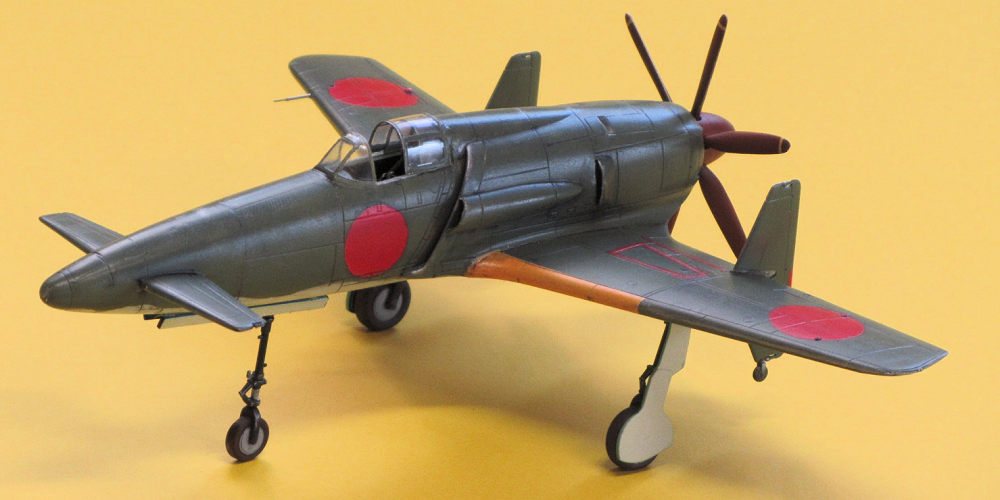
Hasegawa 1/72 J7W1 Shinden
| KIT #: | D20 |
| PRICE: | $15.00 at the time |
| DECALS: | One option |
| REVIEWER: | Ryan Grosswiler |
| NOTES: |
|

| HISTORY |
Still strange to our eyes, the canard is actually the most efficient fixed-wing aircraft configuration. For a variety of reasons: your horizontal 'tail' surface is generating much less induced drag, there is better maneuverability at high angles of attack, and stall characteristics are much more benign. Faster, quicker, and safer, in short. Both the Wright Brothers, Alberto Santos-Dumont, and others selected that configuration for their pioneering aircraft. However, Louis Bleriot blew this emerging trend out of the water with his XI monoplane, the aircraft type which by its popularity and feats firmly established the familiar tractor-engine, wings-first, cruciform-tailplane-second airframe layout as the accepted Conventional Aircraft Configuration, becoming the norm by about 1912.
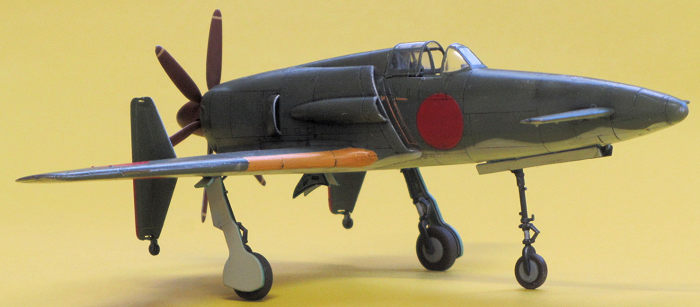 Fast
forward to 1943. A young Japanese Navy captain by the name
of Masayoshi Tsuruno, sensing the slip of his nation's
technological edge in an increasingly costly war,
conceptualized an all-new single-engine fighter in the
revived canard layout, a great leap forward to boldly
reassert Japanese air supremacy. Tsuruno's ideas were
considered promising enough that three proof-of-concept
gliders were built to explore them. These tests were so
successful that the third glider was actually fitted with a
small engine for powered flights, and design of a full-sized
interceptor fighter was begun before even these tests were
completed.
Fast
forward to 1943. A young Japanese Navy captain by the name
of Masayoshi Tsuruno, sensing the slip of his nation's
technological edge in an increasingly costly war,
conceptualized an all-new single-engine fighter in the
revived canard layout, a great leap forward to boldly
reassert Japanese air supremacy. Tsuruno's ideas were
considered promising enough that three proof-of-concept
gliders were built to explore them. These tests were so
successful that the third glider was actually fitted with a
small engine for powered flights, and design of a full-sized
interceptor fighter was begun before even these tests were
completed.
The definitive design was drawn up around the 2130
hp Mitsubishi Ha-30 radial engine buried behind the pilot
and the armament of 4x 30mm Type 5 cannon grouped in the
nose to provide devastating concentration of fire. Eventual
conversion to turbine power was contemplated all along. Even
with the use of a six-bladed propeller, the ground clearance
required at takeoff rotation nonetheless necessitated a very
high, stalky landing gear arrangement, resulting in a
cockpit sill fully 10 feet off the ground.
The first prototype was completed
in the spring of 1945 and a second not long after that,
but flight was delayed by cooling problems with the buried
engine and waiting for some final components, plus a prop
strike during the high-speed taxi tests. Capt. Tsuruno
himself finally took his inspiration up for a test-hop on 3
August 1945, with two more short sorties over the next
week totaling about 45 minutes. Nothing is recorded in
English about the Shinden's demonstrated performance or
handling during these flights,
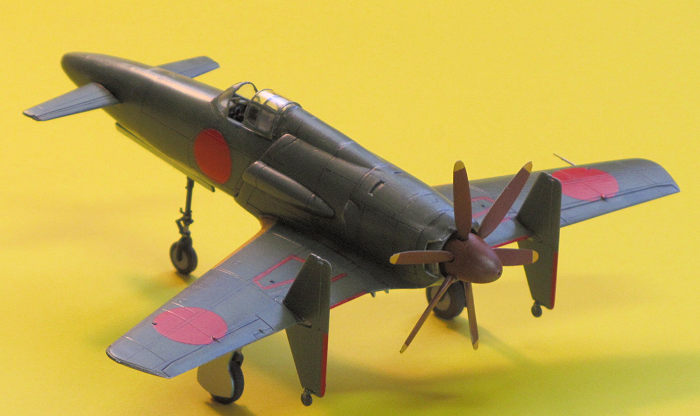 except
for serious vibrations from the prop shaft and propeller
blades, and a marked tendency to yaw during takeoff
acceleration--both of which would have been absolved in the
jet version. Good or bad, flight test results were made moot
by larger events going on simultaneously. One of the
prototypes (the first or second; sources differ) was taken
to the USA and readied for further tests which never
occurred.
except
for serious vibrations from the prop shaft and propeller
blades, and a marked tendency to yaw during takeoff
acceleration--both of which would have been absolved in the
jet version. Good or bad, flight test results were made moot
by larger events going on simultaneously. One of the
prototypes (the first or second; sources differ) was taken
to the USA and readied for further tests which never
occurred.
Postwar, the canard concept was forgotten for a while, surfacing from time to time in supersonic form, primarily in the XB-70 and Sukhoi T-4 bomber prototypes, plus the highly successful SAAB Viggen fighter. It would be the latter which inspired a young engineer named Burt Rutan to design a light canard aircraft, simple, safe and extraordinarily efficient, suitable for construction by the amateur in his garage. This one design triggered the homebuilt aircraft trend-explosion of the Seventies, which in turn finally established the canard as permanent fixture in the skies.
| THE KIT |
That jet-fighter nose and canopy,
nicely proportioned swept wings, turbine-like prop back
there, plus the way it seems to stand a mile off the ground
on that gawky landing gear all add up to making this
aircraft surely one of WWII's Top Five Coolest Prototypes,
flavored with the mystery of What Might Have This Airplane
Been? As a result, this aircraft type which only made three
short flights has been as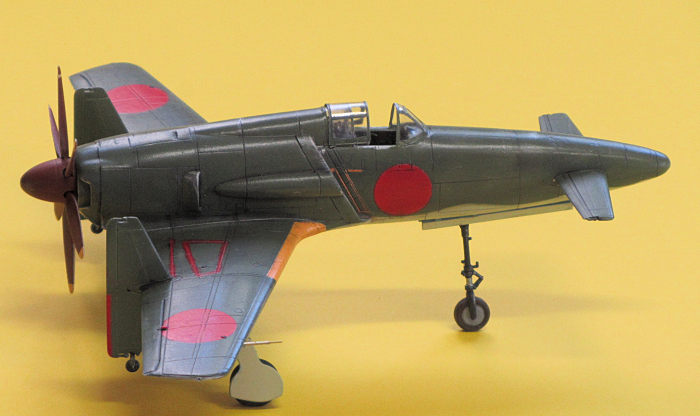 toundingly well-served
in plastic. Hasegawa's nice 1/48th rendition has been
available since the '70s, while Zoukei-Mura recently
released a 1/32 kit with stunning detail inside and out,
pantographed in 1/48. In 1/72, Tamiya had one from about
1965, not a bad kit, but decidedly unrefined in detail.
Hasegawa released the one reviewed here in the mid-'90s to
bring this fascinating aircraft to today's standards for the
small-scale crowd.
toundingly well-served
in plastic. Hasegawa's nice 1/48th rendition has been
available since the '70s, while Zoukei-Mura recently
released a 1/32 kit with stunning detail inside and out,
pantographed in 1/48. In 1/72, Tamiya had one from about
1965, not a bad kit, but decidedly unrefined in detail.
Hasegawa released the one reviewed here in the mid-'90s to
bring this fascinating aircraft to today's standards for the
small-scale crowd.
Predictable Hasegawa fare here: nice, petite recessed panel lines on parts carried on two longish grey sprues, with a single piece canopy (clear and free from distortion) on a third. Disappointingly, the decals on my sample were totally destroyed by chemical/environmental factors in the intervening years since purchase (most likely Hasegawa's production process of the time, as the sheet of an even older bagged Ki-44 also stored in the Shinden's box was unaffected) and found flaking away from the sheet when I pulled the kit from storage to look it over.
| CONSTRUCTION |
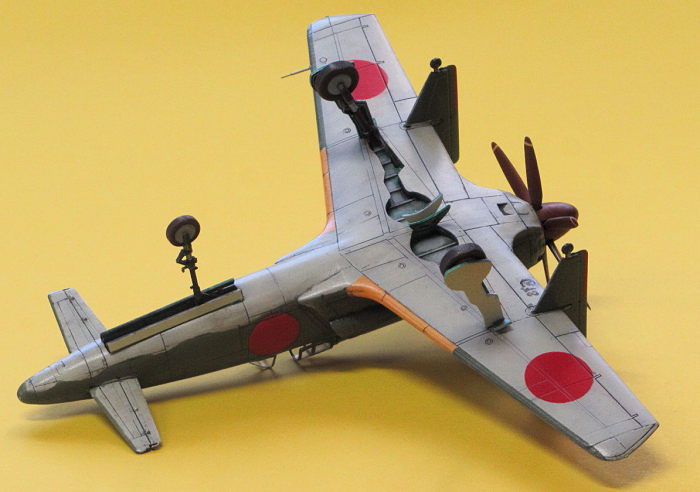 Easy,
and I'd intended this to be a fun, totally out-of-the-box
quick build.
Easy,
and I'd intended this to be a fun, totally out-of-the-box
quick build.
However, the dead-as-a-doornail decal sheet meant that I couldn't use the kit instrument panel decal, which led to a scratch built instrument panel, which led to more interior detailing, and pretty soon I was replacing the kit's nice injected canopy with a Falcon vac-formed one (from Set # 25), slid open to show all that work, with careful painting and weathering to set it off. So much for that quick build! Sometimes I'm just a rat in a maze...
This detour
passed, the nose wheel well was glued in, fuselage
halves joined, and lead buckshot fused into the extreme nose
to keep the finished model in a three-point attitude. The
rest was just simple assembly. Be careful attaching the
spinner backing (Part D14); it's easy to get it reversed. No
disaster if you do, but the finished prop/spinner assembly
will stick out a bit too much and feature an odd, fluted
look. The prop shaft was slightly squashed with a gentle
squeeze from a pair of small pliers to achieve a press-fit.
Fit is good but not excellent, and a
lick of filler and sanding/rescribing is needed here and
there. The biggest concern is the fit of the wing assembly
to the fuselage: the wing is about .5mm too deep for the
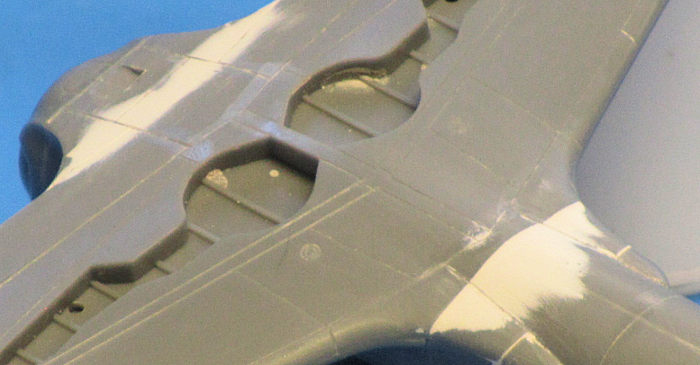 corresponding
receptacle in the fuselage, and I opted for the discrepancy
to occur on the underside of the model to make correction
(more filling/sanding/rescribing) much
easier. It's really such a small step that most modellers
will wisely choose to simply ignore it.
corresponding
receptacle in the fuselage, and I opted for the discrepancy
to occur on the underside of the model to make correction
(more filling/sanding/rescribing) much
easier. It's really such a small step that most modellers
will wisely choose to simply ignore it.
Wanting to depict an unarmed prototype airframe, I also shaped and cemented four simple blanking plates for the cannon ports, sanding them lightly when cured for a refined, contoured look. The supplied VHF antennas were omitted as period photos show them absent. Landing gear parts were cleaned up for separate painting.
| COLORS & MARKINGS |
Lacking decals, I made lemonade out of lemons to use
this as an opportunity for my very first ever all masked and
airbrushed scheme! Following the usual IJN Grey on bottom
IJN Green up top, circles were cut from Tamiya tape using my
marvelous new DSPIAE Stepless Circle Cutter, and then the
no-step
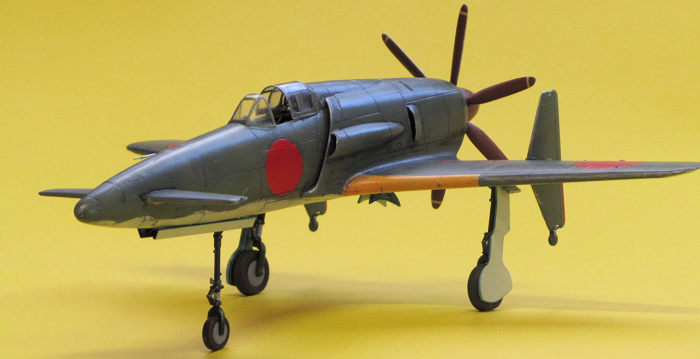 and
warning stripes with more bits of same.
Masking markings only took about an hour. A quick pass with
flat white was followed with insignia red and the no-decals
problem was behind me.
and
warning stripes with more bits of same.
Masking markings only took about an hour. A quick pass with
flat white was followed with insignia red and the no-decals
problem was behind me.
That landing gear is really wobbly and will fold up beneath the finished product if you're not careful. Especially the mains. Contemplating flooding their bases with J&B Weld, I ended up simply inverting the model with the gear tacked in place at the correct angle and applying multiple liberal brushings of MEK, thoroughly melting the joining plastic, and letting it cure overnight. It's all good now.
| CONCLUSIONS |
The DOA decals and wing fit problem aside, this was an enjoyable project and I like the look of it standing tall among my other WWII single-engine types. Get one of the newer releases if you want a useable set of markings.
| REFERENCES |
If you would like your product reviewed fairly and fairly quickly, please contact the editor or see other details in the Note to Contributors.
Back to the Main Page Back to the Review Index Page Back to the Previews Index Page